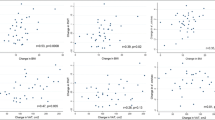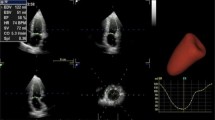Abstract
Background and aims: Obesity is one of the most common diseases in the world. Particularly in elderly subjects, the effects of weight loss on cardiac functions have not been previously investigated by means of pulsed wave tissue doppler imaging (PWTDI). Using PWTDI, we examined the effects of weight loss on cardiac functions and left ventricular (LV) mass in obese geriatric women. Methods: Thirteen obese women aged 66–83 years (mean age 71.2±4.9 yrs) with a body mass index 35.&49 kg/m2 (mean body mass index 39.9±4.3 kg/m2) were evaluated by echocardiography and PWTDI. Only subjects with uncomplicated obesity were included. All measurements, including anthropometric variables, systolic and diastolic indices, and LV mass, were made before and after a 6-month Orlistat plus hypocaloric diet. Myocardial systolic wave (Sm) velocity, isovolumic acceleration (IVA), myocardial precontraction time (PCTm) and the PCTm to contraction time (CTm) ratio were calculated as systolic indices. Early diastolic wave (Em), late diastolic wave (Am), Em to Am ratio, myocardial relaxation time (RTm), deceleration time (DT) and isovolumic relaxation time (IVRT) were determined as diastolic measurements. Results: Subjects lost an average of 8.4±1.2 kg. LV mass decreased significantly after weight loss (p<0.001). In addition, IVRT decreased significantly (p=0.038). Only RTm decreased significantly (p=0.016), whereas other PWTDI parameters of LV remained the same. In the right ventricle, Sm velocity, IVA, Em, and Am velocities were similar. However, the PCTm to Am ratio decreased significantly (p=0.006), and the Em to Am ratio increased (p=0.04) and RTm decreased significantly (p=0.016) after weight loss. Conclusions: In obese geriatric women, weight loss improves ventricular diastolic functions and decreases LV mass. It also contributes to partial improvement in right ventricular systolic function.
Similar content being viewed by others
References
Pascual M, Pascual DA, Soria F et al. Effects of isolated obesity on systolic and diastolic left ventricular function. Heart 2003; 89: 1152–6.
Adams KF, Schatzkin A, Harris TB et al. Overweight, obesity, and mortality in a large prospective cohort of persons 50 to 71 years old. N Engl J Med 2006; 355: 763–78.
Kruger J, Ham SA, Prohaska TR. Behavioral risk factors associated with overweight and obesity among older adults: the 2005 National Health Interview Survey. Prev Chronic Dis 2009; 6: 1–17.
Peterson LR, Waggoner AD, Schechtman KB et al. Alterations in left ventricular structure and function in young healthy obese women. J Am Coll Cardiol 2004; 43: 1399–404.
Alpert MA. Obesity cardiomyopathy: pathophysiology and evolution of the clinical syndrome. Am J Med Sci 2001; 321: 225–36.
Powell BD, Redfield MM, Bybee KA, Freeman WK, Rihal CS. Association of obesity with left ventricular remodeling and diastolic dysfunction in patients without coronary artery disease. Am J Cardiol 2006; 98: 116–20.
Karason K, Wallentin I, Larsson B, Sjöström L. Effects of obesity and weight loss on left ventricular mass and relative wall thickness: survey and intervention study. BMJ 1997; 315: 912–6.
Willens HJ, Chakko SC, Lowery MH et al. Tissue Doppler imaging of the right and left ventricle in severe obesity (Body Mass Index > 35 kg/m2). Am J Cardiol 2004; 94: 1087–90.
Wong CY, O’Moore-Sullivan T, Leano R, Byrne N, Beller E, Marwick TH. Alterations of left ventricular myocardial characteristics associated with obesity. Circulation 2004; 10: 3081–7.
Schiller NB, Shah PM, Crawford M et al. Recommendations for quantitation of the left ventricle by two-dimensional echocardiography. American Society of Echocardiography Committee on Standards, Subcommittee on Quantitation of Two-Dimensional Echocardiograms J Am Soc Echocardiogr 1989; 2: 358–67.
Devereux RB, Reichek N. Echocardiographic determination of left ventricular mass in man. Anatomic validation of the method. Circulation 1977; 55: 613–8.
De Simone G, Devereux RB, Daniels SR, Koren MJ, Meyer RA, Laragh JH. Effect of growth on variability of left ventricular mass: assessment of allometric signals in adults and children and their capacity to predict cardiovascular risk. J Am Coll Cardiol 1995; 25: 1056–62.
Crisostomo LL, Araujo LMB, Camara E et al. Comparison of left ventricular mass and function in obese versus nonobese women < 40 years of age. Am J Cardiol 1999; 84: 1127–9.
Otto ME, Belohlavek M, Khandheria B, Gilman G, Svatikova A, Somers V. Comparison of right and left ventricular function in obese and nonobese men. Am J Cardiol 2004; 93: 1569–72.
Levy D, Anderson KM, Savage DD, Kannel WB, Christiansen JC, Castelli WP. Echocardiographically detected left ventricular hypertrophy: prevalence and risk factors. The Framingham Heart Study. Ann Intern Med 1988; 108: 7–13.
Levy D, Garrison RJ, Savage DD, Kannel WB, Castelli WP. Prognostic implications of echocardiographically determined left ventricular mass in the Framingham Heart Study. N Engl J Med 1990; 322: 1561–6.
Maniscalco M, Arciello A, Zedda A et al. Right ventricular performance in severe obesity. Effect of weight loss. Eur J Clin Invest 2007; 37: 270–5.
Willens HJ, Chakko SC, Byers P et al. Effects of weight loss after gastric bypass on right and left ventricular function assessed by tissue Doppler imaging. Am J Cardiol 2005; 95: 1521–4.
Crisostomo LL, Araujo LMB, Camara E et al. Left ventricular mass and function in young obese women. Int J Obes 2001; 25: 233–8.
Dorbala S, Crugnale S, Yang D, Di Carli MF. Effect of body mass index on left ventricular cavity size and ejection fraction. Am J Cardiol 2006; 97: 725–9.
De Simone G, Romano C, Caprio CD et al. Effects of sibutramine-induced weight loss on cardiovascular system in obese subjects. Nutr Metab Cardiovasc Dis 2005; 15: 24–30.
Alpert MA, Terry BE, Mulekar M et al. Cardiac morphology and left ventricular function in normotensive morbidly obese patients with and without congestive heart failure, and effect of weight loss. Am J Cardiol 1997; 80: 736–40.
Author information
Authors and Affiliations
Corresponding author
Additional information
The study was presented orally at the 7th National Congress of Geriatrics in Izmir, Turkey, but not published in full or in part
Rights and permissions
About this article
Cite this article
Varli, M., Turhan, S., Aras, S. et al. Effects of weight loss on ventricular systolic and diastolic functions and left ventricular mass assessed by tissue doppler imaging in obese geriatric women: preliminary report. Aging Clin Exp Res 22, 206–211 (2010). https://doi.org/10.1007/BF03324798
Received:
Accepted:
Published:
Issue Date:
DOI: https://doi.org/10.1007/BF03324798




